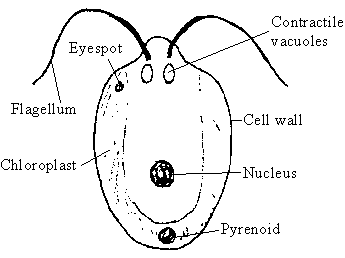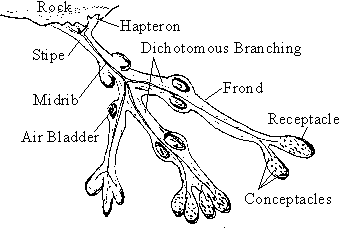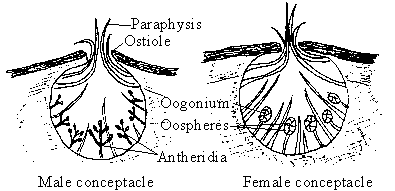Education Links
Leaving Cert
 Maths
Maths
 French
French
 English
English
 Chemistry
Chemistry
 Physics
Physics
 Biology
Biology
 Economics
Economics
 Spanish
Spanish
 Geography
Geography
 History
History
Junior Cert
Most are aquatic.
They have a basic structure called a thallus, i.e. the plant body is not divided into roots, stem and leaves.
Within the group there is a great variety of size and structure from the single-celled Chlamydomonas to the giant seaweeds.
We will look at three examples of algae:
(a) The unicellular type - Chlamydomonas.
(b) The filamentous type - Spirogyra.
(c) The brown seaweed - Fucus vesiculosis.
Chlamydomonas

- Microscopic, green alga.
- Unicellular and haploid.
- Motile and found in stagnant water e.g. ponds.
Spirogyra
Spirogyra is a green alga found on the surface of ponds and slow moving rivers and streams.Vegetative structure

Reproduction
Asexual reproduction
This is the normal method of reproduction for spirogyra. Filaments break into small lengths or single cells. By mitosis and cell enlargement each piece grows into a new filament.
Sexual reproduction
Sexual reproduction occurs when conditions are unfavourable e.g. the pond dries up. Sexual reproduction in Spirogyra is called conjugation. Each cell of the Spirogyra is a gamete (i.e. a haploid sex cell).
Conjugation in Spirogyra
 1. Two filaments line up side by side.
1. Two filaments line up side by side.2. Bulges appear from opposite cells.
3. The bulges touch off each other.
4. The wall between the cells break down and form a conjugation tube.
5. The protoplasts of one filament shrink faster than the other and move through the conjugation tubes. These cells are known as the male gametes (because they move). The stationary protoplasts are called the female gametes.
6. The nuclei fuse and form a diploid zygote. The stages are more or less simultaneous in all cells of a filament. Therefore after fertilisation there is one filament of empty cells and one containing zygotes.
7. The zygote forms a thick wall and is then called a dormant zygospore.
8. The cell walls rupture and the dormant zygospores are liberated.
9. When favourable conditions return the zygospores germinate by meiosis. Only one of the four haploid daughter nuclei survives and divides by mitosis to form a new filament.
Isogamy and Heterogamy
Isogamy is the fusion of similar gametes (isogametes).
Heterogamy is the fusion of gametes that are totally different from each other (heterogametes).
Spigrogyra is an example of isogamy. Fucus is an example of heterogamy.
Fucus
Fucus is a genus of multicellular marine-living brown algae. There are three species of fucus found on the Irish rocky seashore.(a) Fucus vesiculosis
(b)Fucus serratus
(c) Fucus spiralis
Fucus vesiculosis
Vegetative structure
The plant body is a thallus (i.e. not differentiated into roots, stem and leaves). The thallus has three major regions:
1. The hapteron or holdfast attaches the plant to the rock.
2. The stipe is a flexible stalk that joins the hapteron to the rest of the plant.
3. The frond is a flat, much branched leathery structure.
It is brown in colour due to the pigment fucoxanthin. It also has chlorophyll present.

Reproduction
Asexual reproduction
This is not very common. The only method of asexual reproduction shown by fucus is fragmentation when parts which break away become established as new plants.
Sexual reproduction
This is the usual method of reproduction for the fucus. Fucus vesiculosus is dioecious, i.e. separate male and female plants.
1. The tips of the fronds enlarge to form receptacles. Each receptacle contains conceptacles.
2. The gametes are formed in the conceptacles.

3. Meiosis in the antheridium followed by four mitoses produce sixty four haploid sperm cells.
4. Meiosis in the oogonium followed by one mitosis produces eight haploid egg cells (or oospheres).
5. When the tide is out the plant loses water, which causes it to shrink. The shrinking receptacles squeeze mucilage out of the conceptacles through the ostiole.
6. The mucilage carries the mature oogonia and antheridia onto the surface of the receptacles. The mucilage is secreted by the paraphysis.
7. When the tide comes in, the mucilage is washed away, the antheridia and oogonia rupture releasing the gametes into the open sea.
8. The egg cells being more dense than water sink to the bottom. The sperm cells swim and are attracted to the non-motile eggs by a chemical substance (chemotaxis). Many sperm may surround each egg.
9. One sperm enters and fertilises the egg. This results in a diploid zygote being formed.
10. The zygote germinates immediately. By mitosis and differentiation the zygote develops into a mature diploid plant.
Adaptive features of the fucus
Structural adaptions
Life cycle adaptions
Leaving certificate higher level past exam questions
Question 1
Referring to both structure and reproduction give three reasons why Fucus is considered more evolved than Spirogyra.Answer
Question 2
Compare and contrast Fucus and Spirogyra under the following headings: (i) habitat, (ii) structure, (iii) methods of reproduction.Answer
Question 3
The process of gamete formation in most of the plants you have studied in your biology course does not involve meiosis. Is this statement valid? Briefly explain your answer.Answer
Leaving certificate higher level exam questions
1999 Q.10, 1998 Q.6(b), 1997 Q.6, 1996 Q.3, 1996 Q.15(c), 1995 Q.10(b)(c), 1993 Q.10, 1992 Q.3, 1991 Q.15(a).

